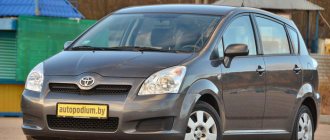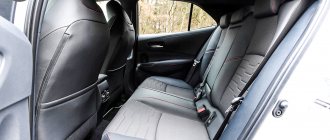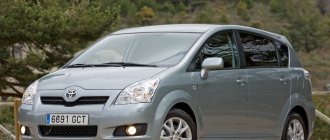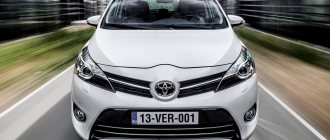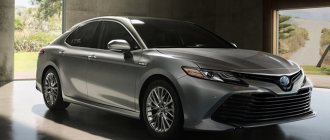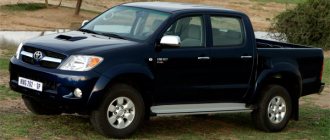| Year of issue: | 2003 |
| Body type: | Sedan |
| Transmission: | automatic |
| Generation: | 9th generation |
| Engine: | gasoline, 1800 cc, 1 hp |
| Fuel consumption on the highway: | city10 highway 8-14 l/100km |
| Steering wheel: | Left |
| Body color: | blue mother of pearl |
| Interior color: | gray velor |
Choosing a car. My experience of owning cars before this purchase was limited to domestic products No. 2 such as Taz 2106,2107,2108, and I was also tormented a little by GAZs. Having given up on the domestic manufacturer, I started choosing the make and model of the car. I had no doubt that it should be Japanese. The target was 2002-03, 15-16 thousand bucks. Based on the numerous opinions of people who have and have not owned the Japanese auto industry, according to the information in sales advertisements, according to technical specifications and articles from the Internet, I concluded that there are several options. Civic, Corolla, Lancer were the main contenders for my wallet. I accidentally wandered onto the website ebay.com, saw an American Toyota and realized what I wanted. In Moscow there were about five or seven of them by that time. At the car dealership they offered me 42,000 km, to which I showed them a carfax of this car with 160,000 thousand km. The price dropped immediately from 15800 to 14800 (I wanted 14700).
Design. First impressions were amazing, well, after the basins. I actually fell for this car because of its appearance. Aggressive, not like a Corolla-style body. The factory body kit gives volume and power in motion. The design of the headlights, foglights, rear lights, and spoiler indicate that this car wants to please a young street racer more than a well-deserved three-heart attacker.
Ergonomics. Let's start with the disadvantages. Uncomfortable seating, the seats look like they came from an American pickup truck, without proper grip and back support; European and Japanese ones are much more comfortable. When we start the engine, we hear and feel it. In cold weather it heats up quickly. The tachometer shows 1900-2100 rpm, but then quickly slows down and settles at 900 rpm. min. I found the ergonomics very comfortable. All instruments are clearly readable, buttons and switches are within reach. The white instrument panel glows pleasantly in the night interior of the car, the button illumination is green - that’s okay too. Good sound from 6 speakers. Spacious interior, no doubt about it!!
Read also: Deprivation of rights 3 times punishment
Dynamics. The most interesting moment comes, how does this Corolla, swollen from factory tuning and the letter S on the back, drive? With an engine of 136 horses, my car is faster than its European counterparts. The mischief of the engine is especially felt after 4000 rpm. The most thrilling thing is when at 80-90 / h you run into a sluggish car on the highway, and oncoming traffic is very close to each other. At this moment it will come in handy for a Corolla weighing 1200 kg + 2-3 people in the cabin, its 136 horsepower. Instant switching from fourth to second, up to 120 (which is enough for overtaking), then third quickly fourth and I’m back at my cruising speed of 130-140 km/h. In general, many people here complain about automatic brakes in different cars. One can say about this automatic transmission that it is generally balanced with the engine, except for switching from first to second, here I sometimes figure it out myself when to release the gas to switch.
Suspension, control. The suspension is a little harsh, but I really appreciate its oaky qualities on the track. With good tires, the Corolla sticks to the asphalt at 120-140 like the Red Arrow train. What I like most is taxiing. Despite the non-separated beam at the rear (like in the nine), the car listens to the steering wheel very, very clearly.
Results. I've owned my whisk for over a year. Drove 18,000 km. Apart from filters, belts, pads, oil and fluids, nothing else was changed, and this despite its impressive 160,000 km. The most frightening thing is the disposability of the engine. According to all information, 1zz-fe engines are not rebuilt. Fuel consumption in the city is 9.5-10, on the highway 7-8 (100-110 km/h), 13-15 (150-160 km/h). The worst thing about this car is the lack of climate control and what is generally outrageous is the ABC (with automatic transmission - no comment). Prices for spare parts and service are the same as classmates of other brands from Japan. + design, efficiency, spacious interior, roomy trunk, good power reserve, super-reliability. — poor equipment, low ground clearance (body kit), sloppy front seats.
We have great prices on Toyota Corolla USA parts and a large selection. When making a purchase in the Forward Auto online store, you will receive exactly the product you ordered.
Read also: How to properly weld a truck frame
If you have any difficulties finding the right spare part, call us and our managers will try to help.
Features of Corolla power units
All units of this model, which have been installed on the Corolla since 2003, are particularly sensitive to the quality of the fuel used and require timely oil changes (subject to the use of fluid recommended by the manufacturer). In addition, the engine loves proper operation and regular maintenance, and then it will work without complaints for hundreds of kilometers.
A feature of all Toyota Corolla power units, both with the 1.8 liter engine and the less powerful 1.6 liter version, is the timing chain. The presence of a chain drive reduces the need for frequent maintenance and increases the life of the engine, making it more practical.
Each engine is equipped with an intelligent Dual VVT-i injection system. It ensures minimal fuel consumption even at maximum engine speed. Each engine installed on the Corolla is a 4-cylinder in-line unit with 16 valves. It is distinguished by a combination of optimal dynamism and efficiency, which improves the technical equipment of the car.
To decide which engine is better - 1.6 or 1.8 liters, you should compare their technical features and parameters, and also read reviews from the owners. Then the conclusions will be objective and based on real operating experience.
Engine Specifications
The 1.6 S engine is the first one under consideration. Its dynamism and power are characterized by indicators such as piston stroke and displacement, which are 78.5 mm and 1598 cm³, respectively. In addition, the engine is characterized by a torque of 157 Nm at 5200 rpm, and at 6000 rpm its maximum power thrust is 122 hp. With.
Depending on the type of transmission, the acceleration rate to the maximum permissible speed varies, which is 185 km/h (with a CVT) and 195 km/h (six-speed manual). Acceleration time is 10.5 seconds (manual) and 11.1 (automatic).
Fuel consumption: when driving around the city does not exceed 8.7 liters, when traveling on highways - from 5.3 liters, when driving combined - no more than 6.6 liters.
This unit was installed on versions of the Corolla both before and after 2003. It is combined with both a mechanical transmission and a CVT. Moreover, when used in combination with a transmission, the robot is more economical.
The 1.8 S engine is a good competitor to the previous unit. Its displacement is slightly higher and amounts to 1798 cm³, and the piston length is increased to 88.3 mm. At 6000 rpm, the maximum power reaches 140 horses, and at 4000 rpm the torque is within 173 Nm. The unit reaches a speed of 100 km/h in 10.2 seconds. Gasoline consumption: in city traffic – 8.3 liters, when driving on the highway – 5.3 liters, in combined driving – 6.3 liters.
The 1.8 S engine is only available in combination with a CVT transmission, and its efficiency indicators are slightly better than those of the second unit.
It is worth noting that all engines, both before and after 2003, are designed to consume A-95 gasoline.
Review of Toyota Corolla 1.4 16v VVT-i (2003)
Hello, dear site visitors.
Since you opened my review, then, apparently, this modification interests you. I hope that I will help someone make a choice. Before choosing this car, this site was my guide to the world of cars.
And now, in order.
I moved to the Corolla in 2108. Impressions are like moving from a cart into a spaceship. When the old owner gave it a ride before buying it, I no longer wanted to leave the driver’s seat. When braking for the first time, according to VAZ’s habit, I pressed the brake pedal with decent force - heads miraculously stopped a centimeter from the dashboard, now I just put my foot on the pedal - the car brakes itself.
At the time of purchase the speedometer showed 82,000 km. The condition of the car is new, despite the decent mileage. There was a small chip of paint and primer on the back door next to the glass - three years have passed without a hint of rust. The suspension absorbs road unevenness fairly well, but the car does not rock. Doesn't bite on the primer. Noise insulation is at an average level, its flaws are especially evident when you drive through large puddles - at first I looked in fear at the mats, wondering if water was pouring on them :) The interior is very spacious, there is absolutely no extraneous noise, the plastic is high-quality, pleasantly soft. Rear passengers also feel quite comfortable.
Ground clearance only fails in winter. A couple of times he sat down dead on his belly where the vases managed to break through. But compared to many other foreign cars, at least it exists. It is quite possible to go fishing and into the forest. The trunk is very large and roomy. The seats are comfortable. When driving long distances you don’t get tired at all. Handling is also excellent. The electric booster does its job. The ABS made my heart skip a beat a couple of times and I nervously peered at the approaching bumper in front of the braking car, but at the last moment the car stopped where it needed to be. Without ABS, it would probably have rolled with the wheels locked towards OSAGO.
In general, impressions of handling, comfort, quality and size of the interior are only positive.
Now about reliability, spare parts and their prices.
According to the previous owner, there were no breakdowns. Only consumables, such as pads, oil, filters and headlight bulbs. By the way, the latter periodically burn out (which is somewhat annoying, since replacement is not very convenient), but they cost pennies. After I put the car in the garage, the engine cooled down and the next day I tried to start it, but I only succeeded the third time. I thought I was doing something wrong. But on a cold engine this happened again and again (sometimes it would start the fifth time). I read on the forums, it turned out that I’m not the only one having this problem - it’s UTT (Toyota morning trouble). There were different tips for eliminating it, but there was no clear system.
First, I changed the fuel filter (RUB 800), but it is located in the gas tank, which somewhat complicates the replacement procedure. I exchanged it with the officials and paid another 600 rubles for the work. Quite acceptable. Did not help. I changed the spark plugs (400 rubles) - it didn’t help. They also advised (on the forums) to change the fuel pump (supposedly it does not hold the required pressure) - but pay 5000 rubles. for the fact that it is possible and does not act up, I did not dare. The car did not start the first time. Moved from 95 to 92. The number of attempts has decreased. That is, not from the fifth or fourth, but from the second or third, it began to start. I changed the gas station from Rosneft to Lukoil. And lo and behold. Now the car always starts the first time. Saved on the fuel pump :) By the way, the lowest temperature in which I started it and drove it was -37C. True, the starter had to be cranked.
Replacement of brake pads (front and rear) - 800 RUR. (Japanese non-original front and back), the original ones cost about 3500 rubles. I took the first ones and am very pleased, replacement costs 200 rubles. from unofficials.
At about 110 thousand, the car refused to start at all, and even in a foreign city, which is not very pleasant. The starter was silent. Fortunately, the engine was warmed up and I stopped on the hill - the kind townspeople pushed it and it started from the pusher without any problems. I returned home and went to an electrician, who diagnosed that the starter had died. I called the store - a new one costs 13,000 rubles. At this time, the electrician dismantled the old one, from which the remains of brushes and burnt wires fell out. Two hours later the electrician called and said that after replacing the brushes it worked like new. By the way, the starter costs a lot. It still starts with half a turn. Yes, by the way, on a cold engine it will not start from the pushrod, it was checked when the battery died.
112,000 km - a strange whistle of unknown origin appeared when driving at a speed of about 100 km/h. I listened to the engine - not him. After 50 km, the source clearly determined that the left front wheel was heating up and squealing very pitifully. I hobbled into town at a speed of 10-15 km/h, with stops to cool down. Unofficial station - replacement of the front bearing (labor - 500 rubles, official bearing - 2500 rubles).
115,000 km - the rear left wheel began to warm up a little. I went to the officials to diagnose the chassis. They asked what was bothering me. I waited for a car for five hours. I watched on the monitors as she stood in the car wash for four hours, and then hung on the lift for an hour. Of this time, the mechanic was near her for about 15 minutes. I only looked at the left rear wheel from the chassis. No one touched the rest of the chassis. The official verdict is that the rear brake caliper needs to be replaced and cannot be repaired. The price of the part is 16,000 rubles. (they have) + work. Gave 600 rubles. for pseudodiagnosis. I decided that the morning is wiser than the evening. In the morning I stopped by the station to see the unofficials (located in the same building, but on the other side :)) for a more accurate diagnosis. In 30 minutes they repaired the caliper for 800 rubles and gave a guarantee.
125,000 km - replacement of front anti-roll bar struts. Set 1300 rub. + 300 rub. work (for non-officials, of course, I never set foot near official ones).
Well, plus oils and filters, changing fluids (I buy original Toyota oil - 1500 rubles, oil filter - 200 rubles, cabin filter - 600 rubles, air filter - 400 rubles).
Summary.
Considering the mileage, we can say that the car is very reliable, all the breakdowns are minor and this is natural wear and tear. The cost of repairs is pennies. We had to invest a lot more into the eight. There were so many unpleasant little things. I'm absolutely satisfied with the car. I consider it one of the optimal choices in the region of 400 thousand rubles.
I hope I didn't bore you too much with my story.
Reviews
Reviews from owners with real operating experience will help you learn more about the car.
Igor, driving experience - more than 15 years
I read numerous reviews about the Corolla with the 1.8 S engine. I decided to take a chance and take it, especially since it fit the planned budget. Now I don’t regret the purchase for a second. Before this I had a 2003 Corolla with manual transmission. So this is heaven and earth! It moves smoothly and gently from one speed to another, and consumes no more than 7-8 liters of gasoline in the city.
Evgeniy, driving experience – 7 years
I recently bought a Toyota Corolla S 1.8 l 2014. I was very impressed by the reviews about this particular configuration. There are no special complaints about operation so far, I just want to say that the variator requires an oil change no later than every 35–40 thousand km, otherwise it may experience shocks when switching and a whistle. Although at the service station they categorically told me that the oil can be changed even after 60–90 thousand km.
Mikhail, driving experience – 10 years
I have a manual Toyota Corolla with an S 1.8 l engine from 2003. I didn’t buy it new, and even after being in use, it still practically doesn’t require getting under the hood. The only thing I replaced were the stabilizer bushings, and so far there have been no other problems. The suspension is excellent, the car rides smoothly, fits well even in really sharp turns, there is practically no noise in the cabin, both from the engine and from the tires.
Egor, driver with 17 years of experience
This is my eighth car - a 2003 Corolla with a 1.6 liter manual engine. In my opinion, this is the most reliable and high-quality vehicle I have ever owned. I was pleased that in our cold weather (-50 degrees) it worked perfectly all winter, the engine did not stall or freeze. In addition, the machine is inexpensive to maintain, and you can always find original spare parts. If you choose a class C car, Corolla is the best option.
This is my Cow.
Greetings to all car enthusiasts on both sides of the ocean!
We are talking about a Toyota Corolla 2004 model series, purchased in November 2003 for my better half. Now my daughter has moved to this car and, having received her license, began to slowly but surely stress me out about my legs. and not without success.
So, Corolla LE with a 4-speed automatic.
The car was taken new, at that time the body had just been updated. The appearance of this device does not evoke negative emotions. Rather, on the contrary, when I look at her, a smile comes to my face, if I may say so, by itself. Such a frog with a 1.8 engine, 130 hp. The acceleration of this amphibian is quite sharp, the engine turns easily and willingly. Great city car! Driving it around the city is just pure pleasure. The dynamics in the city are enough to impress. But if there are four, or even five people in the car, then the car becomes somewhat quiet, you can already hear that the engine is a little dissatisfied and it shows this through a lack of traction, especially at low speeds. But such a load only happens when the whole crowd of us goes to a restaurant or to friends, where I will certainly snatch a glass of schnapps and, therefore, my wife or daughter is in charge. I can also feel it in the engine when the air conditioning is on. And so everyone has their own planes and usually such problems do not arise. The appetite of this engine is divine by American standards - in the city 30-31 miles per gallon or 7.6-7.8 l/100 km. I don’t even know about the route, all the road trips we took were my Camry. What I especially liked was the high ground clearance (wheels 15). This is especially noticeable in comparison with the previous body (1998-2002), which my wife also had to ride. All obstacles on the road ceased to exist, everything slipped under the bottom. In winter, you install the appropriate tires and with a high seating position, this frog rowed better than my Camryuha, which is lower.
Read also: Hypoid transmission - what is it?
The interior is good. Everything is functional, the quality of the plastic is not bad, there are even plastic wood inserts, and surprisingly, they do not spoil the impression. There is enough space in the back; you can’t even put it next to the number nine. The seats are comfortable for up to two or three hours of continuous sitting, then you look for how to reconfigure something there. The radio is for one CD and there is room for a cassette. Now this is no longer the case. The steering wheel is pleasant to the touch.
The car readily picks up speed up to 130 km/h, then the ardor fades somewhat. At 3000 rpm the speed is 120. in my youth, on my 99, 3000 was at 110 km/h, so it will do for the city. But on a Camry at 3000 the speed is 140.
The device is very reliable. I must admit that my half has given it little mileage over so many years. But during this run nothing broke. All maintenance was carried out on time, gasoline 95 or 98, synthetic oil Mobil. I don’t skimp on car maintenance. But the headlights leave much to be desired. Somehow I felt uncomfortable with my 100% vision (ugh 3 times).
Now the operation of the car has become sharply tougher. This happens when the car falls into the hands of a 17-year-old teenager. Let's see what happens in a year.
There is nothing more to write about. It’s difficult to write about Toyota in general. It doesn’t give adrenaline like a Ferrari or BMW, everything is predictable and reliable. For which I appreciate it. And we get enough adrenaline on various crazy rides. or from mountain biking or rafting or. A lot of everything. And the car should please you with ease of problems and confidence that you will definitely get from point A to point B.
